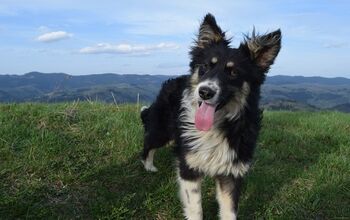Fall Safety Tips for Dogs

As the leaves change color and temperatures drop, it’s important to remember that the fall season can also introduce unique safety concerns for our pups. From seasonal health concerns to potential accidents, there are many risks to consider. Luckily, there are also precautions you can take to ensure your dog stays safe and healthy throughout the autumn months.
In this blog post, I’ll introduce you to the most common fall dangers as well as essential fall safety tips to reduce the risk, allowing you and your dog to enjoy the season and all your favorite fall activities.
Watch for Signs of Seasonal Allergies
Just like us, our dogs can suffer from an increased risk of seasonal allergies in the spring and fall seasons. This could include fall flowers, ragweed, dust mites, mold, and more.
For dogs, the most common signs of seasonal allergies include:
- Licking excessively (especially their paws)
- Itchy, red, irritated skin
- Excessive scratching or biting at themselves
- Hair loss
- Ear infections
- Head shaking or rubbing their head against things
- Red, watery eyes
- Coughing or difficulty breathing
While seasonal allergies aren’t a life-threatening health risk, anyone who has suffered from them will tell you they are not pleasant. If you notice any of these signs, contact your veterinarian to discuss your options. They may recommend products that can provide much-needed relief, like medicated shampoos, ear solutions, dietary supplements, and other simple solutions. Your dog will thank you!
Be Careful with Corn Cobs
One of the common autumn-themed decorations, you can purchase decorative corn on the cob at most grocery stores and farmer’s markets. While this is a great way to celebrate the season with decorations that can later be composted, making it more environmentally friendly, one major concern – corn cobs.
Your dog may be tempted to nibble on that tasty corn, but they can’t properly digest the cob. This means ingesting a corn cob puts your dog at risk of suffering an obstruction in the digestive tract. These obstructions are painful and, unless treated quickly (often with surgery), can be fatal.
If you are determined to use corn in your autumn decorations, ensure they are secured up and out of your dog’s reach.
Decorate with Your Dog in Mind
Speaking of decorations, switching from a natural solution (like corn) to commercial decorations doesn’t mean you’re eliminating all the risks. Many different seasonal decorations will come out this time of year – lights, fog machines, candles, inflatables, and more. Each of these items carries a risk you should be aware of.
Anything with small pieces that may be ingested could pose a risk of obstruction. Additionally, if you are decorating with electrical components, pay careful attention to the location of electrical cords. Your dog may chew a cord, suffer an electrical shock, or become entangled in the cord.
Finally, anything that contains a real flame should be used with care. One of the most recognizable images associated with Halloween is the glowing grin of a Jack-o-lantern, but if you’re lighting that grin with a real candle, you could be setting yourself up for trouble. Even if your dog shows no interest in trying to chew on or eat the pumpkin itself, there is the risk they will bump into it or knock it over. The same goes for open candles. This carries a risk of burns and the possibility of fires being started in or around your home.
This doesn’t mean you can’t decorate for the season, just that you need to take a little extra care in making decorating decisions. Take a moment to view assess your decorations from your dog’s point of view, especially if you have a young and curious puppy. This may mean sitting on the ground for a moment to see if there are risks you didn’t notice when standing over them.
Think Twice About that Halloween Costume
Speaking of the holidays, are you considering dressing your dog up for Halloween? There is nothing wrong with including your dog in the family costume plans, but take care when choosing what they will wear. Avoid any costumes that contain small parts that could be ripped off and ingested. Additionally, steer clear of costumes with strings that could get wrapped around their necks or get caught on furniture, fences, and other outside objects.
Carefully consider your dog’s comfort with various types of clothing. Are they okay with wearing something on their head? Most dogs aren’t, and that’s okay! If that’s the case, opt for a costume that doesn’t require a headpiece.
If you have a dog who is resistant to wearing any type of clothing (some dogs even struggle with wearing harnesses), you could always play it safe and select a Halloween-themed bandana or a spooky seasonal collar.
Watch Out for Toxic Mushrooms
It’s mushroom season, one of the familiar signs that fall is here. While most mushrooms you will encounter are either non-toxic or will have minimal impact on your dog’s health, there are a few seriously toxic mushrooms that can be found across the United States and around the globe. The problem is that your dog likely isn’t a master in mushroom identification.
Whether you plan on taking a fall hiking trip with your canine companion by your side or just hanging out in the backyard, always keep your eyes open for mushrooms. Add the number for the ASPCA Animal Poison Control Center (1-888-426-4435) to your phone so you can access it quickly in an emergency. After all, accidents happen even to the most diligent and responsible pet parents.
Tick Season is Far from Over
Outdoor-loving dog parents are already well aware that the risk of ticks has risen considerably in recent years. These little pests are showing up all over, carrying bacteria and viruses that could make your dog sick, including Lyme disease, canine babesiosis, rocky mountain spotted fever, and more. But you may not realize we are entering the season when adult ticks usually become the most active.
If you have been actively using tick prevention (conventional or natural) throughout the summer, continue to do so into the autumn months. If not, now is a great time to speak with your veterinarian, do your research, and consider your options.
Take some time to learn how to safely remove a tick from a dog (hint: it doesn’t involve smothering the tick in essential oils or Vaseline, contrary to what social media may suggest). Do a thorough tick check on your dog after every outdoor adventure, even if it’s just in your backyard. Finally, keep a tick removal tool like a tick key or a pair of tweezers somewhere where they can be easily accessed if you do find one of these annoying pests.
Be Mindful of the Local Wildlife
During the fall season, local wildlife like squirrels, raccoons, and even bears (depending on where you live) are more active as they start to prepare for the colder days ahead. This means they are more likely to be out and about when you’re walking or hiking with your dog. Wildlife encounters are not only stressful, but they can create a dangerous situation, causing injuries or exposing your pup to transmittable diseases.
If you are heading outdoors with your pup, be mindful and in the moment. That means leaving the headphones at home or holding off on that “important” phone call until your pup is somewhere safe. Keep an eye open directly around you as well as ahead on the trail, as you may be able to avoid a problem by noticing something up ahead and slowing down to let them pass or turning around.
Pay Attention to Hunting Season
Whether you live out in the wilderness, like we do, or enjoy spending time outdoors, you should be familiar with the various dates associated with hunting season in your area. Hunters aren’t actively looking to harm your dog, but there are far too many situations where a dog is mistaken for something else out in the bush, leading to trouble (people, too!), and it’s avoidable with a little preparation!
If you are heading outdoors and are at risk of running into local hunters, ensure you and your dog are easily visible from a distance. One of the best ways to do this is to invest in coats or vests in the bold color of blaze orange, a color often used by hunters themselves. It’s not a big investment, but a brightly colored reflective dog hunting vest could significantly impact your safety!
Be Prepared for Cooler Temperatures
Early in the fall, the weather often mimics summer, not having fully cooled yet. But that doesn’t last long. Before you know it, the fall season will usher in cooler temperatures and even the arrival of frost and snow in some areas of the country. If you have a dog who is well suited for winter (like a Siberian Husky or Malamute), this may not be of any concern. However, if your dog has a shorter coat, they will likely feel the cold temperatures much more.
Our youngest pup, Lucifer, is an Australian Cattle Dog mix, and while he loves the fall and winter seasons, the cold doesn’t always love him. As soon as the temperatures drop, he noticeably shivers when going outdoors without his gear.
A few key things we have invested in for him include:
- A light fleece sweater for when it’s just starting to get cooler
- A rain jacket for wet days, which can also be paired with the sweater for layers
- A warmer jacket for when the cold weather officially starts to roll in
- Winter boots to keep his paws warm and protected from the salts on the roads
I don’t like to be uncomfortably cold as the temperatures drop, so why should I expect him to? By having these supplies on hand, we are prepared for whatever Mother Nature throws our way.
Enjoy the Fall Season with Your Dog by Following These Tips!
Fall is a beautiful season to get outdoors and explore the eye-catching colors with your dog by your side. However, like any season, it is not without its risks. Familiarizing yourself with the most common fall dangers and following the simple safety precautions discussed above, you can minimize the risk and ensure your dog enjoys the season alongside you without (hopefully) any unwanted trips to the emergency vet.
Remember, a little planning goes a long way in keeping your dog safe and happy through the year, including the cooler days of fall. So, grab your leash, a pumpkin spice latte (for you!), and prepare to make some special fall memories!
Join the PetGuide community. Get the latest pet news and product recommendations by subscribing to our newsletter here.

Britt Kascjak is a proud pet mom, sharing her heart (and her home) with her “pack” which includes her husband John, their 2 dogs – Lucifer and Willow – and their 2 cats – Pippen and Jinx. She has been active in the animal rescue community for over 15 years, volunteering, fostering and advocating for organizations across Canada and the US. In her free time, she enjoys traveling around the country camping, hiking, and canoeing with her pets.
More by Britt























